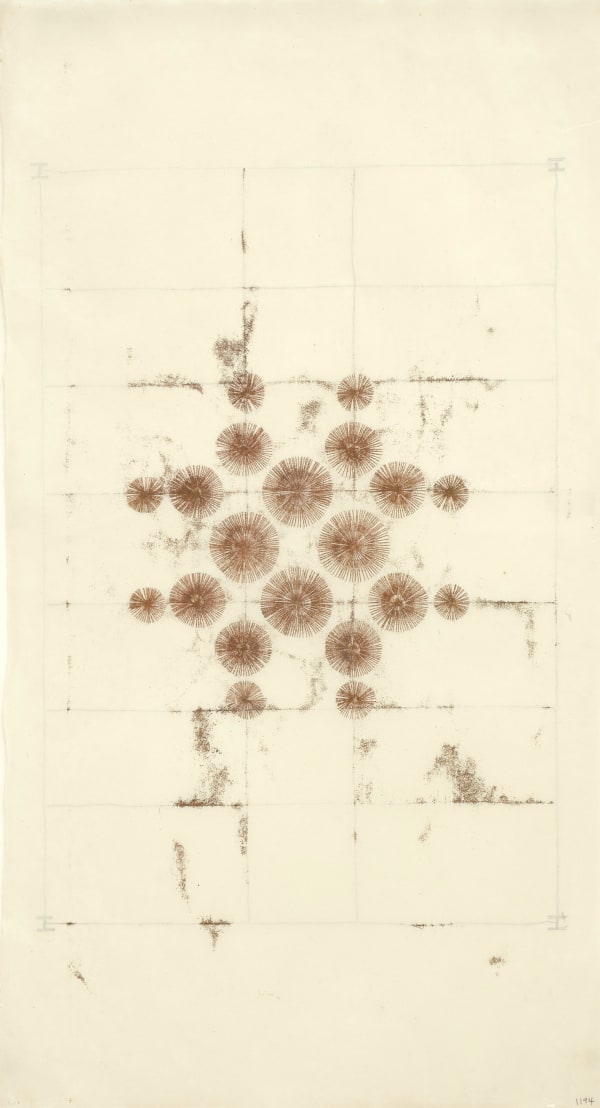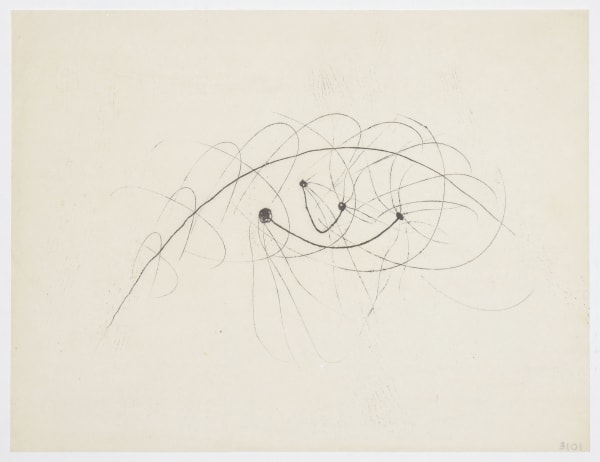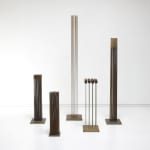Harry Bertoia: In the Great Oneness
A defining figure of Mid-Century Modernism, Harry Bertoia (1915-1978) made sculptures, drawings and jewelry; designed furniture that would prove to be iconic; executed more than 50 large-scale architectural commissions; and experimented with sound by "playing" sculptures he crafted to be both formally beautiful and euphonic.
Born in Northern Italy, he immigrated to the United States when he was 15, joining his older brother in Detroit. He studied at the Detroit Society of Arts and Crafts before receiving a scholarship to the Cranbrook Academy of Art in 1937. At Cranbrook, Bertoia refined his metalworking skills and developed an innovative drawing methodology. But more importantly, he sharpened his sense of material, scale and the spatial acuity which enabled him to move elegantly between metal and paper, the intimate and architectural, solid and void, and physicality and sound.
In the community of Cranbrook -- which included Walter Gropius, Eero Saarinen, Ray and Charles Eames, Edmund N. Bacon and Florence Knoll -- he formed relationships that would put him in the center of 20th Century design. In 1943, he moved to California, where he was part of the team that developed the Eames Lounge Chair. Then, at the invitation of Florence Knoll, he moved to Pennsylvania, where he designed the legendary and eponymous wire furniture collection that continues to be produced by Knoll 75 years after its introduction. Commissioned by architects and designers such as Eero Saarinen, Gordon Bunshaft, I.M. Pei, Henry Dreyfuss, Minoru Yamaski and Edward Durell Stone, he accomplished architectural works that continue to define Mid-Century Modernism.
Harry Bertoia was a virtuoso with metal. His sculptures, made primarily from bronze or beryllium copper, exhibit tremendous technical and aesthetic variety, and range from an inch to several stories high. Frequently referring to nature as a means of expressing the infinite, his forms suggest blossoms, grasses, seedheads, willows or corals. Others seem to refer to totemic figures, mineral deposits, meteorites or mycelium. The surfaces -- sometimes polished, sometimes sensuously encrusted, can seem sedimentary, biological or botanical. They beg to be touched.
In 1960, Bertoia began making sculptures he called "Sonambients," which are as much about the sounds of vibrating metal, as they are about the form of an object. He developed three types of Sonambients from these investigations: "Tonals" which are reed-like groupings of rods welded to a metal base; shaped, hanging "Gongs," meant to be struck or stroked with a mallet; and pairs of suspended rods called "Singing Bars," which reverberate when they meet.
Of course, these bodies of work subvert the art world directive of "don't touch." But more importantly, Harry Bertoia re-imagined the very purpose of sculpture. Momentously, he turned sculpture into a multi-sensory encounter - visual, tactile, and acoustic. This was revolutionary.
Though renowned for his furniture, ambitious public projects, and sculpture, Bertoia's mostly unknown works on paper are the constant throughline -- and perhaps heart - of his practice. Delicate and sensuous, they provide an intimate view into a master's imagination.
Always inventive, he developed an eccentric process while at Cranbrook which he used for the rest of his life. Applying ink to a piece of glass, he'd place a sheet of Japanese paper on it. Then, with a stylus, he drew on the back of the sheet. Not until he pulled the paper from the glass, did he reveal an image, which until that point, was only visible in his mind. Sometimes he used his thumb, the ball of his hand, or household tools to make marks or create atmosphere or tonal shifts. The earliest of these are the most experimental and abstract. By the 1950s, he used the process to think through his sculptures and architectural projects. Each is immediate, intuitive, inventive and not surprisingly, masterful.
Harry Bertoia's work is in the permanent collections of the Museum of Modern Art, New York; the San Francisco Museum of Modern Art; the Solomon R. Guggenheim Museum, New York; the Metropolitan Museum of Art, New York; the Philadelphia Museum of Art; and the Victoria and Albert Museum, London, among many, many others. It has been the subject of major surveys at the Smithsonian American Art Museum, the Museum of Arts and Design in New York, The Nasher Sculpture Center in Dallas and the Cranbrook Art Museum, and his public works can be seen in New York, Philadelphia, Los Angeles, Dallas, Düsseldorf, Brussels, and the campuses of Princeton University and the Massachusetts Institute of Technology. In 2022, the Nasher Sculpture Center produced SCULPTING SOUND: Twelve Musicians Encounter Bertoia, a series of six concerts using Bertoia's "Sonambient" sculptures as instruments.
























